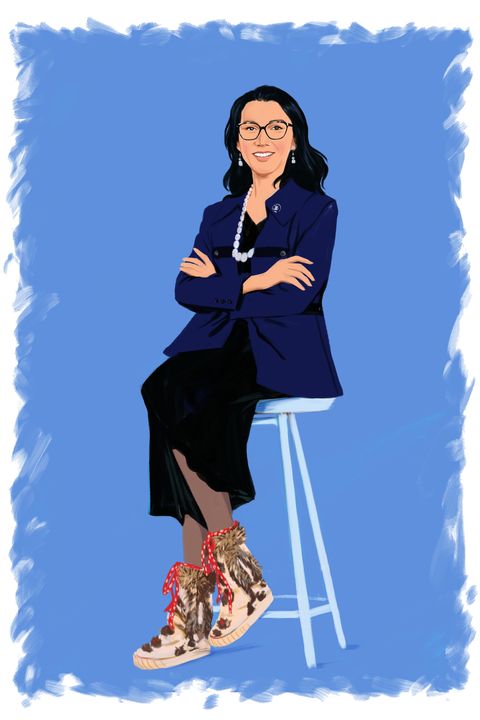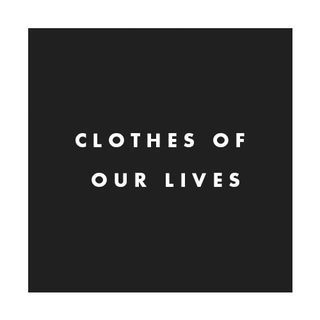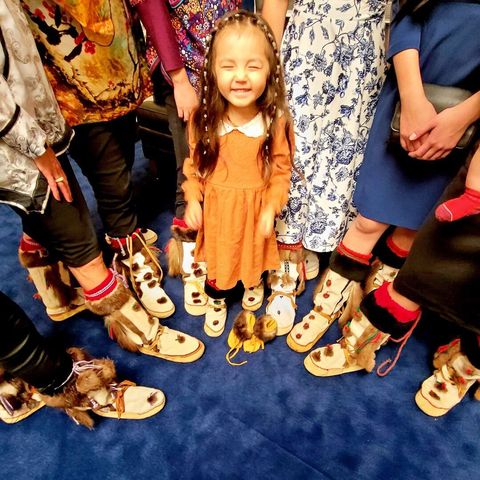This August, Democrat Mary Peltola shocked the nation when she won a special election in Alaska, flipping a long-held Republican seat to become the state’s sole U.S. representative. In doing so, she also made history, becoming the first Alaska Native ever elected to Congress and the first woman to represent the state in the House. “It’s the honor of my life,” Peltola told ELLE.com shortly after she was sworn into Congress, where she’ll complete the current term before going up for re-election in the midterms. Photos from the swearing-in ceremony show the proud Yup’ik Alaska Native beaming, wearing a black dress, blue jacket, and most importantly, a pair of piilugguqs, traditional footwear of the Yup’ik people. “I wanted to pay tribute to the people who helped raise me, who always showed me love, and who would make things for me out of love.”
ELLE’s series Clothes of Our Lives decodes the sartorial choices made by powerful women, exploring how fashion can be used as a tool for communication. Below, in her own words, Peltola shares the story behind her beloved shoes—which she plans to wear again if she wins this November.
When I was sworn into Congress, I knew I wanted to wear something that paid tribute to the Yup’ik culture. Whenever I’m speaking, I try to make sure I’m being inclusive and talking in a collective way. But it’s also important that I accessorize in a way that shows I’m proud of where I come from, I’m proud of the people that I come from, and I’m proud of the values that I was raised with.
Growing up, my mom’s stepsister would always make piilugguqs—in English, you’d call them mukluks—for me. Her English name was also Mary, but we all knew her as Angakaq, her Yup’ik name. She and her husband were really important members of my family, and she passed away about 15 years ago. The two of them didn’t speak a lot of English, but whenever I would come back from school in Colorado in the lower 48, they would ask me questions about what it was like down here. They were just really proud of me, and in wearing these, I wanted to pay tribute to the people who helped raise me, who always showed me love, and who would make things for me out of love. And I was really thankful that all of the women who came to join me for the swearing-in celebration wore theirs as well.
On the day of my swearing-in, most of us had on a certain style called ciivagualgek, which means “ones with the housefly emblems” or atrarutelgek, “ones with the designs going down on each side.” On the front, there are four or five of these fur tufts, which kind of remind you of a housefly. It’s a very common style for women, and to me, it shows that every living thing is of great importance to Yup’ik people, even the lowly housefly. The emblem is also used because in the cold, winter months, they remind us of summer. These boots are a reminder of the cycle of the seasons—and they’re also a reminder of the cycle of life itself. I think it’s wonderful that everything, even the designs that we use, have so much meaning embedded in them. Even the way we decorate and use ornamentation reveals our values and our worldview.
But using piilugguqs in this way is something I actually picked up from the younger generation. Traditionally, piilugguqs have always been worn in the wintertime when there’s snow and ice on the ground, as well as during dance ceremonies. But more recently, young people have started using them for special occasions, like high school or college graduations. It has become much more normalized, and I think it’s a wonderful way to invite our ancestors to be with us and thank them for helping us on our journey here. Elders say that our ancestors are joyful at heart when they see us dressed properly; they say our ancestors see us through a veil, and their joy and happiness and goodwill transcends time and space. That’s what helps us on this side.
The other thing I love about our outerwear is that it’s a survival tool. One of the pieces of advice we all get [when making piilugguqs] is to keep your stitches tight. That’s really about survival and making sure the cold air can’t get in. Piilugguqs are insulated with grass and made with walrus skin, which is very hard, kind of like raw hide. You have to use your teeth to crimp them, so a lot of women who have been making these for a long time, some of their teeth are worn down from doing so. It takes a lot of dedication—and it’s not something you go into lightly.
It’s also important to have a good mentor, because there are thousands of years of best practices. When you make a fur parka, there are so many tips and tricks that have been passed down over generations that make a garment more durable and form-fitting. Again, these aren’t just ceremonial things. These are things that have preserved us for thousands of years.
This interview has been edited and condensed for clarity.
Madison is a senior writer/editor at ELLE.com, covering news, politics, and culture. When she’s not on the internet, you can most likely find her taking a nap or eating banana bread.




